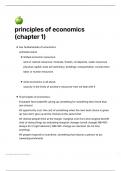Samenvatting
Summary Cel. & Mol. Neurosciences: Partim Molecular Neurosciences
Extensive and clear summary of the part Molecular Neurosciences of Cellular and Molecular Neurosciences. 1. Introduction 2. Interaction between different ion channels 3. Action potential 4. Presynaptic mechanism 5. Postsynaptic mechanism 6. Methods to stimulate neurons 7. Synaptic plas...
[Meer zien]












